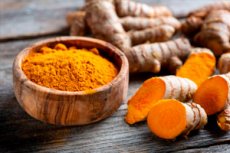New publications
Turmeric vs. Extra Inches: What a Meta-Analysis Shows for Prediabetes and Type 2 Diabetes
Last reviewed: 18.08.2025

All iLive content is medically reviewed or fact checked to ensure as much factual accuracy as possible.
We have strict sourcing guidelines and only link to reputable media sites, academic research institutions and, whenever possible, medically peer reviewed studies. Note that the numbers in parentheses ([1], [2], etc.) are clickable links to these studies.
If you feel that any of our content is inaccurate, out-of-date, or otherwise questionable, please select it and press Ctrl + Enter.

Can you move the needle on the scale and shave a few inches off your waist with curcumin supplementation? A GRADE-assessed systematic review and dose-response meta-analysis of 20 RCTs was published in Nutrition & Diabetes: in people with type 2 diabetes, turmeric/curcumin reduced body weight, waist circumference, proportion of fat mass, and hip circumference on average, and in people with prediabetes, it moderately reduced weight and waist circumference. No effect was found on BMI or waist-to-hip ratio.
Background of the study
Prediabetes and type 2 diabetes almost always go hand in hand with excess adipose tissue, especially visceral. It is associated with insulin resistance, chronic "low-level" inflammation and increased cardiovascular risk. Basic therapy here is a diet with an energy deficit, physical activity and, if necessary, pharmacotherapy. Against this background, there is a growing interest in inexpensive and safe "adjuvants" that could additionally (albeit modestly) shift body weight or waist circumference.
Turmeric and its main polyphenol, curcumin, have long been considered as such a candidate. Their biological plausibility is based on pleiotropic mechanisms: modulation of NF-κB and Nrf2 pathways, influence on adipokines and insulin sensitivity, antioxidant effects. The problem is that curcumin is poorly absorbed, so clinical studies use various “improved” forms (with piperine, phytosomes, nanoparticles), which on the one hand increases bioavailability, and on the other hand, fragments the evidence base into drugs that are incomparable in terms of pharmacokinetics.
So far, randomized trials have provided a mixed picture: small sample sizes, different doses and durations, mixed populations (from obese people to patients with T2D), different endpoints. Plus, many studies looked at BMI, which is not sensitive to local changes in adipose tissue, while waist circumference and the proportion of fat mass are clinically more important. Hence the need for a systematic review with a rigorous methodology (PRISMA/GRADE) and dose-response analysis, focused specifically on prediabetes/T2D and on anthropometric outcomes that better reflect visceral fat.
The practical point of such a review is to bring expectations down to earth. If turmeric/curcumin supplements work, the effect is usually modest and occurs in the context of basic lifestyle changes. However, even small and sustained reductions in waist or fat mass in people with prediabetes/T2D have long-term risk value. So the key questions for the clinic are which forms/doses, for how long, and in whom produce the greatest benefit, and how reproducible these effects are in real-world settings, not just in short RCTs.
The most important thing is in the numbers
- T2D (total 20 RCTs):
- body weight: −1.9 kg (95% CI −2.9; −0.9) - low certainty according to GRADE;
- waist: -1.9 cm (-3.5; -0.2) - low;
- fat mass (%): -2.9 percentage points (-5.6; -0.1) - very low;
- hip circumference: -1.0 cm (-1.2; -0.8) - moderate.
No effects on BMI and WHR were found.
- Prediabetes:
- body weight: -2.5 kg (-4.8; -0.2) - moderate;
- waist: -2.9 cm (-5.3; -0.6) - moderate;
- BMI - no significant changes.
An important detail: the authors found nonlinear “dose/duration → effect” relationships: doses were more strongly associated with waist shift, and duration with weight loss in patients with T2D.
What exactly did they do?
- Looking for RCTs in adults with prediabetes or T2D (1990-2024) comparing turmeric/curcumin with placebo; included weight, BMI, % body fat, waist, hip, WHR.
- We assessed according to PRISMA, calculated the weighted mean difference (WMD) as random effects, and assigned a GRADE to each outcome.
Results
- Curcumin/turmeric produces small but repeatable changes in anthropometry in T2D/prediabetes, especially waist circumference (a measure of visceral fat).
- Where BMI is “silent”, waist and % fat still move - useful for cardiometabolic risk.
Practical tips
- Form and bioavailability: the classic problem with curcumin is low absorption; piperine (20 mg) can increase absorption by 20 times, but the risk of hepatotoxicity is also discussed - do not exceed the dose and consult your doctor before taking it.
- Where the effect is more noticeable: with longer durations and adequate doses; the reference point is chosen by a specific form (regular, “improved”, phytosomal).
- This is a supplement, not a replacement for therapy: metformin, GLP-1RA, lifestyle are the basis; turmeric is an adjuvant.
Limitations to keep in mind
- In many endpoints there is high heterogeneity between RCTs (different doses/formulas/duration).
- For some outcomes, GRADE low or very low is interpreted as a modest signal rather than a “cure for obesity.”
Why do doctors and patients need this?
- For prediabetes and T2D, curcumin supplementation may help modestly reduce weight and waist circumference - especially when combined with a calorie deficit, protein, and steps.
- For monitoring, look not only at BMI, but also at waist/body composition - this is where the effect is most often visible.
Summary
Turmeric/curcumin is not a “magic pill”, but a realistic assistant: minus 1-2 kg and 2-3 cm on the waist in some patients is already a contribution to the control of visceral fat and cardiometabolic risk. The main thing is to choose proven forms, monitor the dose and tolerance, and remember that the main work is still done by diet and exercise.
Source: Moradi Baniasadi M., Arzhang P., Setayesh A., et al. The effect of turmeric/curcumin supplementation on anthropometric indices in subjects with prediabetes and type 2 diabetes mellitus: A GRADE-assessed systematic review and dose-response meta-analysis of randomized controlled trials. Nutrition & Diabetes 15, 34 (2025). https://doi.org/10.1038/s41387-025-00386-7
